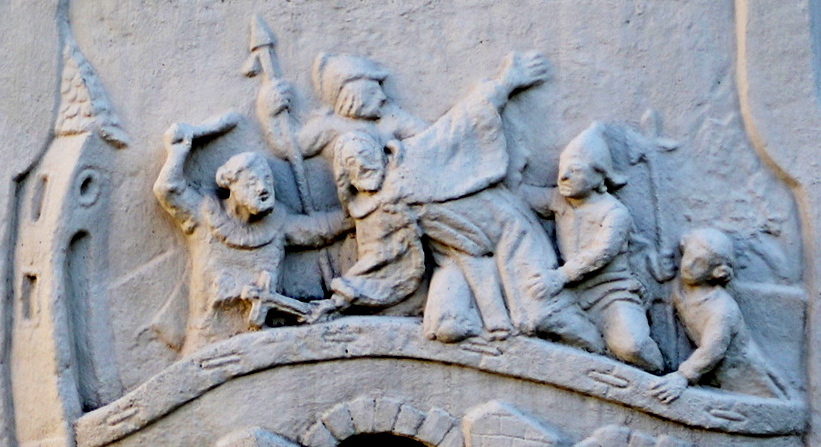On the lawn in front of the parish church of St. Peter and Paul in Erdberg (part of Vienna's 3rd district) stands a statue of St. John of Nepomuk, protector of bridges and protector from plagues, on a carved marble pedestal. Interestingly, a relief carving on the pedestal appears to depict Nepomuk in what appears to be an unsuccessful attempt to defend a bridge. Actually, it is more likely that the relief depicts the Saint's demise, minus the goatskin (see the short bio below).

The statue initially stood in an alcove of the house at Apostelgasse 2, which was torn down in 1971. In 1977 the statue was relocated to its current spot. In amazingly good condition for its age, the statue bears a chronogram (
DIVo nepo
MVCeno t
Vte
Lar
I s
Vo
Instr
VXIt s
Vpp
Le
X)indicating the year it was erected. In the book "Lateinische Inschriften an Bauwerken und Denkmälern Wiens" (Latin inscriptions on buildings and monuments of Vienna) by Karl Janecek, the inscription is translated to "For St. Nepomuk, his protector, erected by one craving for protection".
Auf dem Rasen vor der Erdberger Pfarrkirche Sankt Peter und Paul steht eine Johannes-Nepomuk-Statue auf einem Sockel, der folgendes Chronogramm zeigt:
DIVo nepo
MVCeno t
Vte
Lar
I s
Vo
Instr
VXIt s
Vpp
Le
X
Die römischen Ziffern ergeben das Jahr 1754, in welchem die Statue sehr wahrscheinlich errichtet wurde. Im Buch "Lateinische Inschriften an Bauwerken und Denkmälern Wiens" von Karl Janecek wird die Inschrift mit "Dem hl. Nepomuk, seinem Schützer, von einem Schutzflehenden errichtet" übersetzt.
Saint John of Nepomuk
Saint John of Nepomuk, also called
John of Pomuk or
John Nepomucen, Czech
Svatý Jan Nepomucký, (born c. 1345, Nepomuk, Bohemia [now in Czech Republic]—died March 20, 1393, Prague; canonized 1729; feast day May 16), patron saint of the Czechs who was murdered during the bitter conflict of church and state that plagued Bohemia in the latter 14th century.
In 1383 John began studies at Padua, Italy, where he became a doctor of canon law and subsequently received several church offices. In 1390 he was made vicar general for the archbishop of Prague. In 1393 the archbishop, with John’s support, excommunicated one of the favourites of King Wenceslas IV of Bohemia and thwarted the king’s ambition to make a new bishopric out of the province of Prague. John was arrested as the archbishop’s chief agent. Wenceslas personally tortured him with fire, after which he reconsidered and released him on an oath of secrecy regarding his treatment. John, however, was dying, and to conceal the evidence Wenceslas had him gagged, shoved into a goatskin, and cast into the Vltava River. Bohemian Catholics later regarded him as a martyr.
The Austrian chronicler Thomas Ebendorfferus’s account that John was killed for refusing to reveal to the king the confessions of his wife, Queen Sophia, was officially declared false in 1961.
From The Britannica
